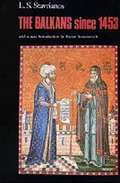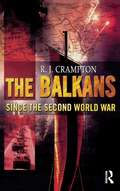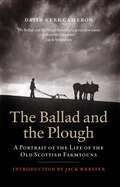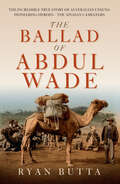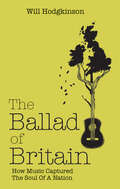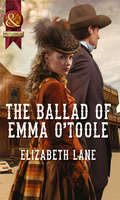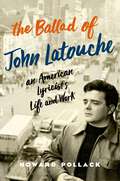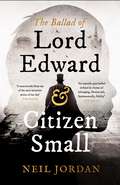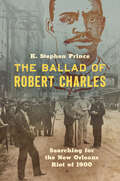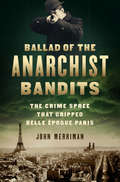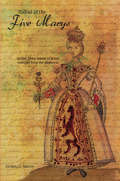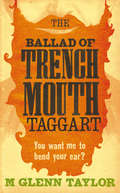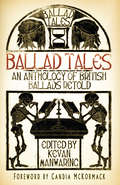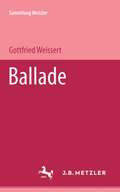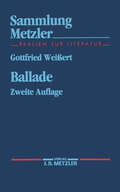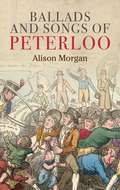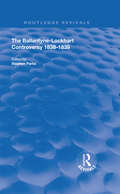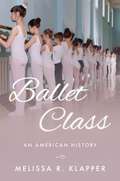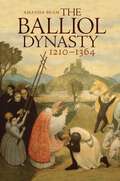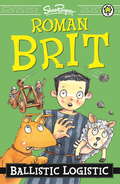- Table View
- List View
The Balkans Since 1543 (PDF)
by L. S. StavrianosThis work aims to synthesize literature on Balkan topics since World War I, and demonstrate the importance of Balkan history by examining it in the context of European and world history. It uses imperial and local approaches, providing national histories as well as contextualising the subject.
The Balkans Since the Second World War
by R. J. CramptonSince the collapse of Eastern European communism, the Balkans have been more prominent in world affairs than at any time since before the First World War. Crises in the area have led NATO to fire its first ever shots in anger, whilst international forces have been deployed on a scale and in a manner unprecedented in Europe since World War Two.An understanding of why this happened is impossible without some knowledge of the history of the area before the fall of communism, of how the communists came to power and how they used their authority thereafter. Covering the communist states of Albania, Bulgaria, Romania and Yugoslavia, and including Greece, Richard Crampton provides a highly readable introduction to that history, one that will be read by journalists, diplomats and anyone interested in the region and its impact on world politics today.
The Balkans Since the Second World War
by R. J. CramptonSince the collapse of Eastern European communism, the Balkans have been more prominent in world affairs than at any time since before the First World War. Crises in the area have led NATO to fire its first ever shots in anger, whilst international forces have been deployed on a scale and in a manner unprecedented in Europe since World War Two.An understanding of why this happened is impossible without some knowledge of the history of the area before the fall of communism, of how the communists came to power and how they used their authority thereafter. Covering the communist states of Albania, Bulgaria, Romania and Yugoslavia, and including Greece, Richard Crampton provides a highly readable introduction to that history, one that will be read by journalists, diplomats and anyone interested in the region and its impact on world politics today.
Ballad and the Plough: A Portrait of the Life of the Old Scottish Farmtouns
by David Kerr CameronThe era of the great farms of Scotland is over now. They flourished for nearly eighty years from the mid 19th century, and those years are renowned for the strength of their characters and the legendary status of their stories. Probably the finest and richest aspect of bothy life was the ballad. Often sentimental, sometimes simplistic, they nevertheless give unrivalled detail about a vanished way of life and work. Quoting generously from the ballads, David Kerr Cameron has written a book rich in anecdote and insight. The working day was hard and long, and mealtimes consisted mainly of porridge and potatoes. Yet laughter and generosity of spirit were commonplace. For these communities, horses were as important as people, and tens of thousands of noble Clydesdales helped to cultivate the land. Ploughmen, dairymaids, bailiffs and shepherds all appear in the pages of this unique testament to the Scottish countryside. Together with Willie Gavin, Crofter Man and The Cornkister Days, this volume forms a remarkable trilogy on life in rural Scotland.
The Ballad of Abdul Wade: The Incredible True Story of Australia's unsung Pioneering Heroes - The Afghan Camelleers
by Ryan ButtaWhen Afghan entrepreneur Abdul Wade first brought his camel trains to the outback, he was hailed as a hero. Horses couldn't access many remote settlements, especially those stricken by flood or drought, and camel trains rode to the rescue time and time again.But with success came fierce opposition fuelled by prejudice. The camel was not even classed as an animal under Australian law, and, in a climate of colonial misinformation, hyperbole and fear, camel drivers like Wade were shown almost as little respect. Yet all the while, for those in need, the ships of the desert continued to appear on the outback horizon.After his interest was piqued by a nineteenth-century photo of a camel train in a country town, Ryan Butta found himself on the trail of Australia's earliest Afghan camel drivers. Separating the bulldust from the bush poetry, he reveals the breadth and depth of white Australian protectionism and prejudice. Told with flair and authority, this gritty alternative history defies the standard horse-powered folklore to reveal the untold debt this country owes to the humble dromedary, its drivers and those who brought them here.
The Ballad of Britain: How Music Captured The Soul Of A Nation
by Will HodgkinsonIn 1903, the Victorian composer Cecil Sharp began a decade-long journey to collect folk songs that, he believed, captured the spirit of Great Britain. A century later, with the musical and cultural map of the country transformed, writer and journalist Will Hodgkinson sets out on a similar journey to find the songs that make up modern Britain. He looks at the unique relationship the British have with music, and tries to understand how the country has represented itself through song. He visits remote pubs in the West Country where families have been passing down local songs for generations, monasteries in Oxfordshire where monks use plainsong to commune with God, sits in with Hindu devotional singers in the suburbs of Birmingham and learns an ancient folk tune from a Sussex farmer. Will goes from the heart of the mainstream music scenes to the very fringes as part of his quest, visiting in turn remote musical heartlands and great urban musical cities. London (The Kinks, The Who and Blur), Liverpool (The Teardrop Explodes, Echo & The Bunnymen, The Beatles), Manchester (Joy Division, Stone Roses, Oasis) and Sheffield (Cabaret Voltaire, The Human League, Pulp and more recently, The Arctic Monkeys) all feature prominently as the respective homes of clusters of great bands that have helped shape the British musical landscape. An engaging blend of humour and musical scholarship, The Ballad of Britian is as much a portrait of Britain as an adventure into lyric and melody. The project forced the author into an itinerant life, scouring the length and breadth of the country for singers and songwriters in an attempt to discover whether songs still travel the way they once did, to find out whether folk music still exists in a meaningful sense, and to see how regional variations contribute to a collective musical ''Britishness''.
The Ballad of Emma O'Toole (Mills And Boon Historical Ser.)
by Elizabeth LaneAfter he shoots a man, the stakes for gambler Logan Devereaux have never been higher. On trial for his life, he’s offered a shocking alternative form of restitution… marriage to his victim’s pregnant sweetheart!
The Ballad of John Latouche: An American Lyricist's Life and Work
by Howard PollackBorn into a poor Virginian family, John Treville Latouche (1914-56), in his short life, made a profound mark on America's musical theater as a lyricist, book writer, and librettist. The wit and skill of his lyrics elicited comparisons with the likes of Ira Gershwin, Lorenz Hart, and Cole Porter, but he had too, noted Stephen Sondheim, "a large vision of what musical theater could be," and he proved especially venturesome in helping to develop a lyric theater that innovatively combined music, word, dance, and costume and set design. Many of his pieces, even if not commonly known today, remain high points in the history of American musical theater. "A great American genius" in the words of Duke Ellington, Latouche initially came to wide public attention in his early twenties with his cantata for soloist and chorus, Ballad for Americans (1939), with music by Earl Robinson-a work that swept the nation during the Second World War. Other milestones in his career included the all-black musical fable, Cabin in the Sky (1940), with Vernon Duke; an interracial updating of John Gay's classic, The Beggar's Opera, as Beggar's Holiday (1946), with Duke Ellington; two acclaimed Broadway operas with Jerome Moross: Ballet Ballads (1948) and The Golden Apple (1954); one of the most enduring operas in the American canon, The Ballad of Baby Doe (1956), with Douglas Moore; and the operetta Candide (1956), with Leonard Bernstein and Lillian Hellman. Extremely versatile, he also wrote cabaret songs, participated in documentary and avant-garde film, translated poetry, adapted plays, and much else. Meanwhile, as one of Manhattan's most celebrated raconteurs and hosts, he developed a wide range of friends in the arts, including, to name only a few, Paul and Jane Bowles (whom he introduced to each other), Yul Brynner, John Cage, Jack Kerouac, Frederick Kiesler, Carson McCullers, Frank O'Hara, Dawn Powell, Ned Rorem, Virgil Thomson, Gore Vidal, and Tennessee Williams-a dazzling constellation of diverse artists working in sundry fields, all attracted to Latouche's brilliance and joie de vivre, not to mention his support for their work. This book draws widely on archival collections both at home and abroad, including Latouche's diaries and the papers of Bernstein, Ellington, Moore, Moross, and many others, to tell for the first time, the story of this fascinating man and his work.
The Ballad of John Latouche: An American Lyricist's Life and Work
by Howard PollackBorn into a poor Virginian family, John Treville Latouche (1914-56), in his short life, made a profound mark on America's musical theater as a lyricist, book writer, and librettist. The wit and skill of his lyrics elicited comparisons with the likes of Ira Gershwin, Lorenz Hart, and Cole Porter, but he had too, noted Stephen Sondheim, "a large vision of what musical theater could be," and he proved especially venturesome in helping to develop a lyric theater that innovatively combined music, word, dance, and costume and set design. Many of his pieces, even if not commonly known today, remain high points in the history of American musical theater. "A great American genius" in the words of Duke Ellington, Latouche initially came to wide public attention in his early twenties with his cantata for soloist and chorus, Ballad for Americans (1939), with music by Earl Robinson-a work that swept the nation during the Second World War. Other milestones in his career included the all-black musical fable, Cabin in the Sky (1940), with Vernon Duke; an interracial updating of John Gay's classic, The Beggar's Opera, as Beggar's Holiday (1946), with Duke Ellington; two acclaimed Broadway operas with Jerome Moross: Ballet Ballads (1948) and The Golden Apple (1954); one of the most enduring operas in the American canon, The Ballad of Baby Doe (1956), with Douglas Moore; and the operetta Candide (1956), with Leonard Bernstein and Lillian Hellman. Extremely versatile, he also wrote cabaret songs, participated in documentary and avant-garde film, translated poetry, adapted plays, and much else. Meanwhile, as one of Manhattan's most celebrated raconteurs and hosts, he developed a wide range of friends in the arts, including, to name only a few, Paul and Jane Bowles (whom he introduced to each other), Yul Brynner, John Cage, Jack Kerouac, Frederick Kiesler, Carson McCullers, Frank O'Hara, Dawn Powell, Ned Rorem, Virgil Thomson, Gore Vidal, and Tennessee Williams-a dazzling constellation of diverse artists working in sundry fields, all attracted to Latouche's brilliance and joie de vivre, not to mention his support for their work. This book draws widely on archival collections both at home and abroad, including Latouche's diaries and the papers of Bernstein, Ellington, Moore, Moross, and many others, to tell for the first time, the story of this fascinating man and his work.
The Ballad of Lord Edward and Citizen Small
by Neil JordanFrom multi-award-winning author and film director Neil Jordan comes a thrilling reimagining of a turning point in Irish, American and European history. 'A masterwork from one of the most inventive artists of our day' John Banville 'A writer of uncommon talent' Irish Times 'An expertly spun ballad defined by themes of belonging, illusion and fidelity' RTÉ CultureEutaw Springs, South Carolina, 1781, the American War of Independence. A runaway slave saves the life of Lord Edward Fitzgerald, a British army officer and the younger son of one of colonial Ireland's grandest families.The tale that unfolds is related by Tony Small, the slave who becomes Fitzgerald's manservant and friend. While details of Lord Edward's life are well documented, little is known of Tony Small. In this gripping narrative his character considers the ironies of empire, captivity and freedom, mapping Lord Edward's journey from being a loyal subject of the British Empire to becoming a leader of the disastrous 1798 rebellion.This powerful new work of fiction brings Neil Jordan's inimitable storytelling ability to the drama of real events and a long-forgotten chapter in Ireland and Britain's history.
The Ballad of Robert Charles: Searching for the New Orleans Riot of 1900
by K. Stephen PrinceFor a brief moment in the summer of 1900, Robert Charles was arguably the most infamous black man in the United States. After an altercation with police on a New Orleans street, Charles killed two police officers and fled. During a manhunt that extended for days, violent white mobs roamed the city, assaulting African Americans and killing at least half a dozen. When authorities located Charles, he held off a crowd of thousands for hours before being shot to death. The notorious episode was reported nationwide; years later, fabled jazz pianist Jelly Roll Morton recalled memorializing Charles in song. Yet today, Charles is almost entirely invisible in the traditional historical record. So who was Robert Charles, really? An outlaw? A black freedom fighter? And how can we reconstruct his story? In this fascinating work, K. Stephen Prince sheds fresh light on both the history of the Robert Charles riots and the practice of history-writing itself. He reveals evidence of intentional erasures, both in the ways the riot and its aftermath were chronicled and in the ways stories were silenced or purposefully obscured. But Prince also excavates long-hidden facts from the narratives passed down by white and black New Orleanians over more than a century. In so doing, he probes the possibilities and limitations of the historical imagination.
Ballad of the Anarchist Bandits: The Crime Spree that Gripped Belle Epoque Paris
by John MerrimanThe thrilling story of the Bonnot Gang, a band of anarchist bank robbers whose crimes terrorized Belle Époque Paris, and whose escapades reflected the fast-paced, dizzyingly modern, and increasingly violent period on the eve of World War I. For six terrifying months in 1911-1912, the citizens of Paris were gripped by a violent crime streak. A group of bandits went on a rampage throughout the city and its suburbs, robbing banks and wealthy Parisians, killing anyone who got in their way, and always managing to stay one step ahead of the police. But Jules Bonnot and the Bonnot Gang weren't just ordinary criminals; they were anarchists, motivated by the rampant inequality and poverty in Paris.John Merriman tells this story through the eyes of two young, idealistic lovers: Victor Kibaltchiche (later the famed Russian revolutionary and writer Victor Serge) and Rirette Maîtrejean, who chronicled the Bonnot crime spree in the radical newspaper L'Anarchie. While wealthy Parisians frequented restaurants on the Champs-Élysées, attended performances at the magnificent new opera house, and enjoyed the decadence of the so-called Belle Époque, Victor, Rirette, and their friends occupied a vast sprawl of dank apartments, bleak canals, and smoky factories. Victor and Rirette rejected the violence of Bonnot and his cronies, but to the police it made no difference. Victor was imprisoned for years for his anarchist beliefs, Bonnot was hunted down and shot dead, and his fellow bandits were sentenced to death by guillotine or lifelong imprisonment.Fast-paced and gripping, Ballad of the Anarchist Bandits is a tale of idealists and lost causes--and a vivid evocation of Paris in the dizzying years before the horrors of World War I were unleashed.
The Ballad of the Five Marys
by Donald SmithDonald Smith's third historical novel investigates where Mary Queen of Scots' history ends and legend begins through the captivating use of contemporary prose ballad. Smith seeks a truthful narrative about not only Mary Carmichael but also Seton, Beaton, Livingston and Fleming by integrating firsthand accounts and dramatic testimony. It marks 500 years since Flodden and the Birth of John Knox.
The Ballad of Trenchmouth Taggart
by M. Glenn TaylorThere’s little room in this world for a moral man
Ballad Tales: An Anthology of British Ballads Retold
by Kevan ManwaringA BALLAD is a poem or a song that tells a popular story and many traditional British ballads contain fascinating stories – tales of love and jealousy, murder and mystery, the supernatural and the historical. This anthology brings together nineteen original retellings in short story form, written by some of the country’s most accomplished storytellers, singers and wordsmiths. Here you will find tales of cross-dressing heroines, lusty pirates, vengeful fairy queens, mobsters and monsters, mermaids and starmen – stories that dance with the form and flavour of these narrative folk songs in daring and delightful ways. Richly illustrated, these enchanting tales will appeal to lovers of folk music, storytelling and rattling good yarns.
Ballade (Sammlung Metzler)
by Gottfried WeißertDie Ballade im Überblick. Das Wort Ballade ist der Begriff, der sich in Deutschland seit dem letzten Drittel des 18. Jahrhunderts für kurze, erzählende Gedichte im weitesten Sinne durchgesetzt hat. Gottfried Weißert führt in der überarbeiteten 2. Auflage seines Balladen-Bandes in die Theorie der Ballade ein, er gibt einen historischen Abriss und stellt einzelne Arten der Ballade vor.
Ballads and songs of Peterloo
by Alison MorganBallads and songs of Peterloo is an edited collection of poems and songs written following the Peterloo Massacre in 1819. This collection, which includes over seventy poems, were published either as broadsides or in radical periodicals and newspapers. Notes to support the reading of the texts are provided, but they also stand alone, conveying the original publications without diluting their authenticity. Following an introduction outlining the massacre, the radical press and broadside ballad, the poems are grouped into six sections according to theme. Shelley’s Masque of Anarchy is included as an appendix in acknowledgement of its continuing significance to the representation of Peterloo. This book is primarily aimed at students and lecturers of Romanticism and social history.
Ballads and songs of Peterloo (G - Reference, Information and Interdisciplinary Subjects)
by Alison MorganThis is an edited anthology comprising more than seventy poems and songs written in immediate response to Peterloo in 1819. Mainly anonymous, these ballads appears either as broadsides or in the radical press and are collected together for the first time.
The Ballantyne-Lockhart Controversy: 1838-1839 (Routledge Revivals)
by James Ballantyne J. G. LockhartOriginally published in 1974, The Ballantyne-Lockhart Controversy is reprint of three tracts concerning the Ballantyne - Lockhard controversy. Lockhart was the son-in-law of Sir Walter Scott and he made the claim that the Ballantynes played a key role in the financial ruin of Scott. The Ballantynes denied the charges. This book reveals much of interest on publishing and authors during the period.
Ballet Class: An American History
by Melissa R. KlapperSurveying the state of American ballet in a 1913 issue of McClure's Magazine, author Willa Cather reported that few girls expressed any interest in taking ballet class and that those who did were hard-pressed to find anything other than dingy studios and imperious teachers. One hundred years later, ballet is everywhere. There are ballet companies large and small across the United States; ballet is commonly featured in film, television, literature, and on social media; professional ballet dancers are spokespeople for all kinds of products; nail polish companies market colors like "Ballet Slippers" and "Prima Ballerina;" and, most importantly, millions of American children have taken ballet class. Beginning with the arrival of Russian dancers like Anna Pavlova, who first toured the United States on the eve of World War I, Ballet Class: An American History explores the growth of ballet from an ancillary part of nineteenth-century musical theater, opera, and vaudeville to the quintessential extracurricular activity it is today, pursued by countless children nationwide and an integral part of twentieth-century American childhood across borders of gender, class, race, and sexuality. A social history, Ballet Class takes a new approach to the very popular subject of ballet and helps ground an art form often perceived to be elite in the experiences of regular, everyday people who spent time in barre-lined studios across the United States. Drawing on a wide variety of materials, including children's books, memoirs by professional dancers and choreographers, pedagogy manuals, and dance periodicals, in addition to archival collections and oral histories, this pathbreaking study provides a deeply-researched national perspective on the history and significance of recreational ballet class in the United States and its influence on many facets of children's lives, including gender norms, consumerism, body image, children's literature, extracurricular activities, and popular culture.
Ballet Class: An American History
by Melissa R. KlapperSurveying the state of American ballet in a 1913 issue of McClure's Magazine, author Willa Cather reported that few girls expressed any interest in taking ballet class and that those who did were hard-pressed to find anything other than dingy studios and imperious teachers. One hundred years later, ballet is everywhere. There are ballet companies large and small across the United States; ballet is commonly featured in film, television, literature, and on social media; professional ballet dancers are spokespeople for all kinds of products; nail polish companies market colors like "Ballet Slippers" and "Prima Ballerina;" and, most importantly, millions of American children have taken ballet class. Beginning with the arrival of Russian dancers like Anna Pavlova, who first toured the United States on the eve of World War I, Ballet Class: An American History explores the growth of ballet from an ancillary part of nineteenth-century musical theater, opera, and vaudeville to the quintessential extracurricular activity it is today, pursued by countless children nationwide and an integral part of twentieth-century American childhood across borders of gender, class, race, and sexuality. A social history, Ballet Class takes a new approach to the very popular subject of ballet and helps ground an art form often perceived to be elite in the experiences of regular, everyday people who spent time in barre-lined studios across the United States. Drawing on a wide variety of materials, including children's books, memoirs by professional dancers and choreographers, pedagogy manuals, and dance periodicals, in addition to archival collections and oral histories, this pathbreaking study provides a deeply-researched national perspective on the history and significance of recreational ballet class in the United States and its influence on many facets of children's lives, including gender norms, consumerism, body image, children's literature, extracurricular activities, and popular culture.
The Balliol Dynasty: 1210-1364
by Amanda BeamThis study examines the political ambitions and influences of the Balliol dynasty in the thirteenth and fourteenth centuries in Scotland, England and France. The generally accepted opinion in previous historiography was that John (II), king of Scots from 1292 to 1296, and Edward Balliol (d. 1364) were politically weak men and unsuccessful kings. In a reassessment of the patriarch of the family, John (I) (d.1268), the Balliols are revealed as committed English lords and loyal servants of the kings of England, underlining how the family has been unfairly judged for centuries by both chroniclers and historians, who have assessed them as Scottish kings rather than as English lords.Despite the forfeiture of the Balliol estates in England and Scotland in 1926, John (II) and Edward retained close relationships with the successive English kings and used these connections to fuel their political ambitions. Their kingships illustrate their desires to recover some influence in English politics which the family had enjoyed in the mid-thirteenth century. This re-evaluation of the Balliols highlights their relationship with the English crown.
Ballistic Logistic: Book 2 (Roman Brit)
by Shoo RaynerThe Legion want to build a road to transport their giant catapult. But the road will go right through Brit's barn, which is full of food for his flocks! Then the soldiers start firing at the sheep. Can Brit save his beloved animals - and their food for the winter?
Ballistic-Missile Defence and Strategic Stability (Adelphi series)
by Dean A. WilkeningShould the US deploy ballistic-missile defences? The arguments for and against are becoming increasingly polarised. This paper offers what is currently lacking in the debate: a quantitative analysis of how well defences would have to work to meet specific security objectives, and what level of defence might upset strategic stability.
